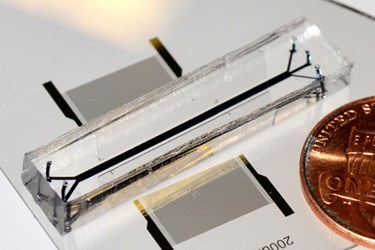Acoustic Tweezers Separate Cancer Cells From Blood Cells

Using sound waves, researchers have developed a method of separating circulating tumor cells (CTCs) from regular blood cells that is much gentler and more cost-effective than existing methods. The new device provides a potential way for clinicians to obtain undamaged CTCs for diagnostic, prognostic, and treatment purposes.
The multifluidic device, referred to as “acoustic tweezers,” was designed by a team of scientists from the Pennsylvania State University (Penn State), Carnegie Mellon Universtiy, and the Massachusetts Institute of Technology (MIT). According to a Penn State press release, the device is approximately the size of two pennies laid side by side.
The design works by using tilted-angle standing surface acoustic waves to apply pressure to a continuous flow of blood. Cancerous cells are forced out of the stream according to their differential size and weight into a different channel, where they are collected.
Acoustic waves used in the process are similar in frequency and intensity to those used in fetal ultrasounds, so the process is extremely gentle — the researchers said the CTCs collected experienced no damage and required no labeling or surface modification. Because the device interacts with human blood and would require easy disposability, developers designed the device to be inexpensive to mass produce.
“Looking for circulating tumor cells in a blood sample is like looking for a needle in a haystack. Typically, the CTCs are about one in every one billion blood cells in the sample,” said Tony Jun Huang, professor of engineering science and mechanicals at Penn State, in the press release.
According to the research team’s study, published in Proceedings of the National Academy of Sciences of the United States of America (PNAS), acoustic methods for cell separation are ideal because they cause minimal damage. However, previous attempts at developing an acoustic separation process have been unsuccessful because of insufficient throughput and device stability.
The authors believe that they have overcome these limitations with their new method and report a throughput rate 20 times higher than previously achieved with similar devices, along with a separation rate of more than 83 percent.
Researchers said that if the device is further developed, it could be used to diagnose cancer and also monitor patient reactions to chemotherapy.
“It promises to offer new avenues for basic research into the pathology and metastasis, and for clinical diagnosis of rare tumor cells,” said Subra Suresh, a study author from Carnegie Mellon.
CTC separation and cancer diagnostics are the newest development in the team’s tilted-angle acoustic research. Last December, the team published a study in PNAS that used acoustic waves to manipulate cell spacing and contact.
Image credit: Tony Jun Huang, Penn State
